ETHIOPIA (incl. Rock Churches at Lalibela
extension)
For our tour description, itinerary,
past triplists, dates, fees, and more, please VISIT OUR TOUR PAGE.
See this triplist in printable PDF format with media only on
page 1.

Spot-breasted
Lapwing is a lovely plover of high-elevation grasslands, one
that has presumably declined greatly in the face of
agriculture. It is still reasonably common on the Sanetti
Plateau, where we look for Ethiopian Wolf. (Photo by guide
Richard Webster)
Success can be defined in many ways, and by most ways our
journey around Ethiopia was a success. It was a birding tour,
and we had great success finding Ethiopia's special birds,
including some with small populations and very limited ranges.
The subtitle to this birding tour also mentioned a certain
Wolf, and we were very successful in seeing not only Ethiopian
Wolf, but several other endemic mammals. The tour was also a
logistical success: the group's curiosity about seeing much of
the diversity of Ethiopia, including regions well off the
tourist track, was also satisfied thanks to the
behind-the-scenes work of Experience Ethiopia Tours and the
on-the-scenes management of Kibrom.
May is in advance of the main rainy season in Ethiopia, and
this year was no exception in the north, which was brown,
locally tinged green. Some rain may reach southern Ethiopia in
April and May, and this year was an exception in that major
rain had fallen in the southern third of the country, as it
had in neighboring Kenya. Fortunately we happened to avoid
coinciding with the heaviest downpours, and were able to get
everywhere and enjoy an extraordinarily green landscape, and
many singing and breeding species (although in a few cases,
some birds may have dispersed, e.g., from Sof Omar).
The trip started with three days of birding on the
escarpments and dry valleys north of Addis Ababa. While the
avifauna of the agricultural highlands is limited, many of the
endemics occur here, and we saw perhaps half of our eventual
total just in these three days. Venturing lower on the slopes
added many more widespread species. Highlights from this
section included Blue-winged Goose, Wattled Ibis, Harwood's
Francolin, White-collared Pigeon, Ethiopian (Tropical) Boubou,
White-rumped Babbler, Rueppell's Chat, White-winged
Cliff-Chat, Ankober and Yellow-throated serins, and Red-billed
Pytilia.
Heading south from Addis, we traveled to the desert
environment of Bilen Lodge, our lowest elevation of the tour
but still 3,000' above Ethiopia's low point of the Danakil
Depression. We were fortunate to find Arabian Bustard there,
along with many other fine birds, including Spotted
Thick-knee, Abyssinian Roller, Yellow-breasted Barbet, and
Nile Valley and Shining sunbirds. Returning up the Rift
Valley, we entered the dry bush country of Awash National
Park, where we enjoyed the hospitality of Awash Falls Lodge,
located on the rim of the canyon within sight of the falls.
Although human encroachment has limited the mammals, we did
see Beisa Oryx, Salt's Dik-dik, and Soemmering's Gazelle.
Avian pleasures included Four-banded Sandgrouse, White
Helmetshrike, Rosy-patched Bushshrike, Gillet's Lark singing
at length, Somali Fiscal, and, on the nearby lava fields, the
very local Sombre Chat.
Moving south up the Rift Valley, we stopped at several lakes
and then based ourselves at Lake Langano for some of the
"birdiest" days of the trip. Memorable species from this
segment and our night at Lake Awassa later included African
Pygmy-Goose, White-backed Duck, Black Heron canopy feeding,
Gray Kestrel, tame Black Crake, Lesser Jacana, White-winged
Terns in breeding plumage, Black-winged Lovebird feeding at
close range, Rufous-necked Wryneck, Gray-headed Bushshrike,
White-winged Black-Tit, many weavers in breeding plumage, and
Abyssinian (Fawn-breasted) Waxbill.
For many, the most distinctive and special environment was
the Bale Mountains, and the national park of that name. Based
in Goba and using 4WD, we traveled as high as 4,300m on the
Sanetti Plateau, and above treeline had repeated looks at
perhaps six different Ethiopian Wolves, one of which had just
captured a Giant Root-Rat. Bird species were few, but included
the striking Spot-breasted Lapwing, Chestnut-naped and
Moorland francolins, and Rouget's Rail, plus the bonus of
Wattled Cranes being around this year. Forests on both slopes
provided more new birds, incuding White-cheeked Turaco,
Abyssinian Woodpecker, Abyssinian Catbird, White-backed
Black-Tit, and Dark-headed Oriole. The park's protection also
allowed us to have great views of Mountain Nyala and Menelik's
Bushbuck. Our day trip to Sof Omar had a lucky connection with
Salvadori's Serin, some other good birds (Narina Trogon,
Bristle-crowned Starling), and for those who wanted, a walk
into the scenic and historic cave.
Two stops in the remote south provided access to a few more
endemics and many species shared with Kenya's arid north. In
Negele we considered ourselves fortunate to find two of the
most difficult birds of the trip. Prince Ruspoli's Turaco
responded with surprising ease, and we had another later,
while the Sidamo (Liben) Lark, threatened with extinction,
took some looking and puzzling, but our one ended up
wonderfully cooperative. White-crowned Starling was another
special bird, and an aesthetic highlight was provided by late
afternoon light on Red-and-yellow Barbet and a flock of tame
Red-bellied (Orange-bellied) Parrots.
We found Stresemann's Bush-crow even before reaching Yabello,
and had a close-range encounter with a family group feeding
fledged young; this is perhaps Ethiopia's most distinctive
bird. Continuing to bird the region, we found the other local
endemic, White-tailed Swallow, and many other great birds
(Vulturine Guineafowl, Short-tailed Lark, Shelley's,
Golden-breasted, and Magpie starlings, Northern
Grosbeak-Canary, and Shelley's Rufous Sparrow), while some of
us recovered (sigh) from real life, the wrong box lunch. Our
return to Addis was enlivened by two Yellow-fronted Parrots
coming to roost at Wondo Genet, where both parrots and forest
are being depleted at a rapid rate.
Most of the group went on the extension to Lalibela to see
the historic rock-hewn churches. Between visits to the
churches we did go birding, and saw two additional endemics,
Erckel's Francolin (what a performer!) and Yellow-rumped
(White-throated) Seedeater. We also saw many specialties
again, including some of our best views of species such as
Banded Barbet, Abyssinian Black (Schalow's) Wheatear, and
White-billed Starling. The views of Lammergeier from our hotel
and elsewhere were one of the aesthetic highlights of the
trip.
Thanks to all of you for joining us on this trip; it was a
truly memorable experience. Terry and I look forward to
guiding you to another destination someday soon.
--Richard
(Taxonomy follows Clements and supplements to at least a
considerable degree. "Endemic" is used in the sense of Redman,
Stevenson, and Fanshawe, emphasizing the region, not single
countries. Conservation information is drawn from the
publications of BirdLife International.)
KEYS FOR THIS LIST
One of the following keys may be shown in brackets for
individual species as appropriate: * = heard only, I =
introduced, E = endemic, N = nesting, a = austral migrant, b =
boreal migrant
Anatidae (Ducks, Geese, and Waterfowl)
WHITE-FACED WHISTLING-DUCK (Dendrocygna viduata)
FULVOUS
WHISTLING-DUCK (Dendrocygna
bicolor)
WHITE-BACKED DUCK
(Thalassornis leuconotus)
BLUE-WINGED GOOSE
(Cyanochen cyanoptera)
[E]
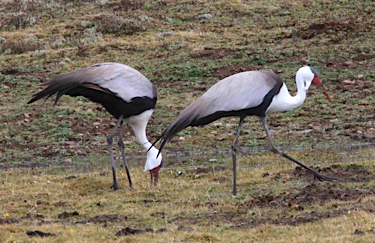
A small, isolated
population of Wattled Cranes occurs in Ethiopia; this pair
occurred with Ethiopian Wolves on the Sanetti Plateau of
Bale Mountains N.P. (Photo by guide Richard Webster)
EGYPTIAN GOOSE (Alopochen aegyptiaca)
RUDDY SHELDUCK
(Tadorna ferruginea)
SPUR-WINGED GOOSE
(Plectropterus gambensis)
AFRICAN
PYGMY-GOOSE (Nettapus auritus)
AFRICAN BLACK DUCK
(Anas sparsa)
YELLOW-BILLED DUCK
(Anas undulata)
NORTHERN SHOVELER
(Anas clypeata) [b]
HOTTENTOT TEAL
(Anas hottentota)
CAPE TEAL (Anas capensis)
SOUTHERN POCHARD
(Netta erythrophthalma)
Numididae (Guineafowl)
HELMETED GUINEAFOWL (Numida meleagris)
VULTURINE
GUINEAFOWL (Acryllium
vulturinum)
Phasianidae (Pheasants, Grouse, and
Allies)
CRESTED FRANCOLIN (Francolinus sephaena)
MOORLAND FRANCOLIN
(Francolinus psilolaemus)
ERCKEL'S FRANCOLIN
(Francolinus erckelii) [E]
HARWOOD'S
FRANCOLIN (Francolinus
harwoodi) [E]
YELLOW-NECKED
FRANCOLIN (Francolinus
leucoscepus)
CHESTNUT-NAPED
FRANCOLIN (Francolinus
castaneicollis) [E]
BLUE QUAIL
(Coturnix adansonii)
Podicipedidae (Grebes)
LITTLE GREBE (Tachybaptus ruficollis)
EARED GREBE
(Podiceps nigricollis)
Phoenicopteridae (Flamingos)
GREATER FLAMINGO (Phoenicopterus roseus)
LESSER FLAMINGO
(Phoenicopterus minor)
Ciconiidae (Storks)
ABDIM'S STORK (Ciconia abdimii)
WOOLLY-NECKED
STORK (Ciconia episcopus)
SADDLE-BILLED
STORK (Ephippiorhynchus
senegalensis)
MARABOU STORK
(Leptoptilos crumeniferus)
YELLOW-BILLED
STORK (Mycteria ibis)
Phalacrocoracidae (Cormorants and Shags)
GREAT CORMORANT (Phalacrocorax carbo)
LONG-TAILED
CORMORANT (Phalacrocorax
africanus)
Anhingidae (Anhingas)
AFRICAN DARTER (Anhinga rufa rufa)
Pelecanidae (Pelicans)
GREAT WHITE PELICAN (Pelecanus onocrotalus)
PINK-BACKED
PELICAN (Pelecanus rufescens)
Scopidae (Hamerkop)
HAMERKOP (Scopus
umbretta)
Ardeidae (Herons, Egrets, and Bitterns)
DWARF BITTERN (Ixobrychus sturmii)
GRAY HERON
(Ardea cinerea)
BLACK-HEADED HERON
(Ardea melanocephala)
GOLIATH HERON
(Ardea goliath)
GREAT EGRET
(Ardea alba)
LITTLE EGRET
(Egretta garzetta)
BLACK HERON
(Egretta ardesiaca)
CATTLE EGRET
(Bubulcus ibis)
SQUACCO HERON
(Ardeola ralloides)
BLACK-CROWNED
NIGHT-HERON (Nycticorax
nycticorax)
Threskiornithidae (Ibises and Spoonbills)
GLOSSY IBIS (Plegadis falcinellus)
SACRED IBIS
(Threskiornis aethiopicus)
HADADA IBIS
(Bostrychia hagedash)
WATTLED IBIS
(Bostrychia carunculata) [E]
AFRICAN SPOONBILL
(Platalea alba)
Accipitridae (Hawks, Eagles, and Kites)
BLACK-SHOULDERED KITE (Elanus caeruleus)
BLACK KITE
(YELLOW-BILLED) (Milvus
migrans parasitus)
AFRICAN FISH-EAGLE
(Haliaeetus vocifer)
HOODED VULTURE
(Necrosyrtes monachus)
LAMMERGEIER
(Gypaetus barbatus)
EGYPTIAN VULTURE
(Neophron percnopterus)
WHITE-BACKED
VULTURE (Gyps africanus)
RUEPPELL'S GRIFFON
(Gyps rueppellii)
LAPPET-FACED
VULTURE (Torgos tracheliotus)
WHITE-HEADED
VULTURE (Trigonoceps
occipitalis)
BLACK-BREASTED
SNAKE-EAGLE (Circaetus
pectoralis)
BATELEUR (Terathopius ecaudatus)
AFRICAN
HARRIER-HAWK (Polyboroides
typus)
DARK
CHANTING-GOSHAWK (Melierax
metabates)
EASTERN
CHANTING-GOSHAWK (Melierax
poliopterus)
SHIKRA (Accipiter badius)
LITTLE SPARROWHAWK
(Accipiter minullus)
AUGUR BUZZARD
(Buteo augur)
TAWNY EAGLE
(Aquila rapax)
VERREAUX'S EAGLE
(Aquila verreauxii)
AFRICAN HAWK-EAGLE
(Aquila spilogaster)
BOOTED EAGLE
(Hieraaetus pennatus)
[b]
AYRES'S HAWK-EAGLE
(Hieraaetus ayresii)
LONG-CRESTED EAGLE
(Lophaetus occipitalis)
Falconidae (Falcons and Caracaras)
PYGMY FALCON (Polihierax semitorquatus)
EURASIAN KESTREL
(Falco tinnunculus)
GRAY KESTREL
(Falco ardosiaceus)
LANNER FALCON
(Falco biarmicus)
PEREGRINE FALCON
(Falco peregrinus)
Otididae (Bustards)
ARABIAN BUSTARD (Ardeotis arabs)
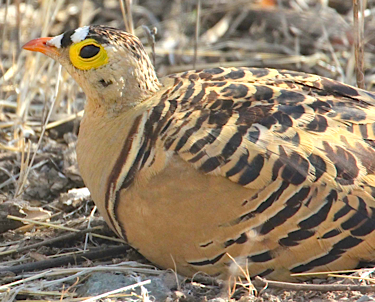
An unexpected
bonus in 2012 was a pair of Four-banded Sandgrouse in
Awash N.P., known from the area, but seldom seen. This
photo shows the brightly-colored male. (Photo by guide
Richard Webster)
KORI BUSTARD (Ardeotis kori)
BUFF-CRESTED
BUSTARD (Eupodotis gindiana)
Rallidae (Rails, Gallinules, and Coots)
ROUGET'S RAIL (Rougetius rougetii)
[E]
BLACK CRAKE
(Amaurornis flavirostra)
EURASIAN MOORHEN
(Gallinula chloropus)
RED-KNOBBED COOT
(Fulica cristata)
Gruidae (Cranes)
WATTLED CRANE (Bugeranus carunculatus)
Burhinidae (Thick-knees)
SENEGAL THICK-KNEE (Burhinus senegalensis)
SPOTTED THICK-KNEE
(Burhinus capensis)
Charadriidae (Plovers and Lapwings)
SPUR-WINGED PLOVER (Vanellus spinosus)
BLACK-WINGED
LAPWING (Vanellus
melanopterus)
CROWNED LAPWING
(Vanellus coronatus)
WATTLED LAPWING
(Vanellus senegallus)
SPOT-BREASTED
LAPWING (Vanellus
melanocephalus) [E]
KITTLITZ'S PLOVER
(Charadrius pecuarius)
THREE-BANDED
PLOVER (Charadrius
tricollaris)
Recurvirostridae (Stilts and Avocets)
BLACK-WINGED STILT (Himantopus himantopus)
PIED AVOCET
(Recurvirostra avosetta)
Jacanidae (Jacanas)
LESSER JACANA (Microparra capensis)
AFRICAN JACANA
(Actophilornis africanus)
Scolopacidae (Sandpipers and Allies)
COMMON SANDPIPER (Actitis hypoleucos) [b]
SPOTTED REDSHANK
(Tringa erythropus) [b]
WOOD SANDPIPER
(Tringa glareola) [b]
BLACK-TAILED
GODWIT (Limosa limosa)
[b]
LITTLE STINT
(Calidris minuta) [b]
CURLEW SANDPIPER
(Calidris ferruginea) [b]
RUFF (Philomachus pugnax) [b]
Glareolidae (Pratincoles and Coursers)
COLLARED PRATINCOLE (Glareola pratincola)
Laridae (Gulls, Terns, and Skimmers)
GRAY-HOODED GULL (Chroicocephalus cirrocephalus)
BLACK-HEADED GULL
(Chroicocephalus ridibundus) [b]
LESSER
BLACK-BACKED GULL (Larus
fuscus) [b]
GULL-BILLED TERN
(Gelochelidon nilotica)
WHITE-WINGED TERN
(Chlidonias leucopterus) [b]
WHISKERED TERN
(Chlidonias hybrida)
Pteroclidae (Sandgrouse)
CHESTNUT-BELLIED SANDGROUSE (Pterocles exustus)
LICHTENSTEIN'S
SANDGROUSE (Pterocles
lichtensteinii)
FOUR-BANDED
SANDGROUSE (Pterocles
quadricinctus)
Columbidae (Pigeons and Doves)
ROCK PIGEON (Columba livia) [I]

White-cheeked
Turaco is the "other" turaco of Ethiopia, seemingly taking
second place to the much-coveted Prince Ruspoli's Turaco
(the discoverer of White-cheeked was not killed by an
elephant!), but this endemic is a real beauty, too. (Photo
by guide Richard Webster)
SPECKLED PIGEON (Columba guinea)
WHITE-COLLARED
PIGEON (Columba albitorques)
[E]
RAMERON PIGEON
(Columba arquatrix)
LEMON DOVE
(Columba larvata)
DUSKY TURTLE-DOVE
(Streptopelia lugens)
MOURNING
COLLARED-DOVE (Streptopelia
decipiens)
RED-EYED DOVE
(Streptopelia semitorquata)
RING-NECKED DOVE
(Streptopelia capicola)
LAUGHING DOVE
(Streptopelia senegalensis)
EMERALD-SPOTTED
WOOD-DOVE (Turtur
chalcospilos)
BLUE-SPOTTED
WOOD-DOVE (Turtur afer)
TAMBOURINE DOVE
(Turtur tympanistria)
NAMAQUA DOVE
(Oena capensis)
BRUCE'S
GREEN-PIGEON (Treron waalia)
Psittacidae (Parrots)
BLACK-WINGED LOVEBIRD (Agapornis taranta) [E]
RED-BELLIED PARROT
(Poicephalus rufiventris)
YELLOW-FRONTED
PARROT (Poicephalus
flavifrons) [E]
Musophagidae (Turacos)
WHITE-CHEEKED TURACO (Tauraco leucotis) [E]
PRINCE RUSPOLI'S
TURACO (Tauraco ruspolii)
[E]
WHITE-BELLIED
GO-AWAY-BIRD (Corythaixoides
leucogaster)
EASTERN
PLANTAIN-EATER (Crinifer
zonurus)
Cuculidae (Cuckoos)
PIED CUCKOO (Clamator jacobinus)
LEVAILLANT'S
CUCKOO (Clamator levaillantii)
RED-CHESTED CUCKOO
(Cuculus solitarius)
BLACK CUCKOO
(Cuculus clamosus)
KLAAS'S CUCKOO
(Chrysococcyx klaas)
AFRICAN EMERALD
CUCKOO (Chrysococcyx cupreus)
DIDERIC CUCKOO
(Chrysococcyx caprius)
BLUE-HEADED COUCAL
(Centropus monachus)
WHITE-BROWED
COUCAL (Centropus
superciliosus)
Strigidae (Owls)
CAPE EAGLE-OWL (Bubo capensis dillonii)
GRAYISH EAGLE-OWL
(Bubo cinerascens)
PEARL-SPOTTED
OWLET (Glaucidium perlatum)
AFRICAN WOOD-OWL
(Strix woodfordii)
Caprimulgidae (Nightjars and Allies)
SLENDER-TAILED NIGHTJAR (Caprimulgus clarus)
Apodidae (Swifts)
ALPINE SWIFT (Apus melba)
MOTTLED SWIFT
(Apus aequatorialis)
NYANZA SWIFT
(Apus niansae)
LITTLE SWIFT
(Apus affinis)
HORUS SWIFT
(Apus horus)
WHITE-RUMPED SWIFT
(Apus caffer)
AFRICAN PALM-SWIFT
(Cypsiurus parvus)
Coliidae (Mousebirds)
SPECKLED MOUSEBIRD (Colius striatus)
BLUE-NAPED
MOUSEBIRD (Urocolius
macrourus)
Trogonidae (Trogons)
NARINA TROGON (Apaloderma narina)
Alcedinidae (Kingfishers)
MALACHITE KINGFISHER (Corythornis cristatus)
AFRICAN
PYGMY-KINGFISHER (Ispidina
picta)
GRAY-HEADED
KINGFISHER (Halcyon
leucocephala)
WOODLAND
KINGFISHER (Halcyon
senegalensis)
STRIPED KINGFISHER
(Halcyon chelicuti)
PIED KINGFISHER
(Ceryle rudis)
Meropidae (Bee-eaters)
LITTLE BEE-EATER (Merops pusillus)
BLUE-BREASTED
BEE-EATER (Merops variegatus)
WHITE-THROATED
BEE-EATER (Merops albicollis)
MADAGASCAR
BEE-EATER (Merops
superciliosus) [a]
Coraciidae (Rollers)
ABYSSINIAN ROLLER (Coracias abyssinicus)
LILAC-BREASTED
ROLLER (Coracias caudatus
lorti)
RUFOUS-CROWNED
ROLLER (Coracias naevius)
BROAD-BILLED
ROLLER (Eurystomus glaucurus)
Upupidae (Hoopoes)
EURASIAN HOOPOE (CENTRAL AFRICAN)
(Upupa epops waibeli)
Phoeniculidae (Woodhoopoes and
Scimitar-bills)
BLACK-BILLED WOODHOOPOE (Phoeniculus somaliensis) [E]
ABYSSINIAN
SCIMITAR-BILL (Rhinopomastus
minor)
Bucerotidae (Hornbills)
NORTHERN RED-BILLED HORNBILL (Tockus erythrorhynchus)
EASTERN
YELLOW-BILLED HORNBILL (Tockus
flavirostris)
VON DER DECKEN'S
HORNBILL (Tockus deckeni)
HEMPRICH'S
HORNBILL (Tockus hemprichii)
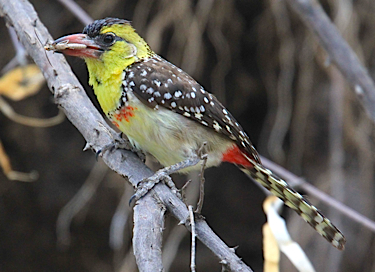
Yellow-breasted
Barbet is an example of a bird that is seen across Africa,
but only in the narrow belt of the Sahel, lying between
the Sahara and wetter, forested belts to the south. This
barbet is about to deliver some insect protein to its
young in a burrow in a bank. (Photo by guide Richard
Webster)
AFRICAN GRAY HORNBILL (Tockus nasutus)
SILVERY-CHEEKED
HORNBILL (Ceratogymna brevis)
ABYSSINIAN
GROUND-HORNBILL (Bucorvus
abyssinicus)
Lybiidae (African Barbets)
RED-AND-YELLOW BARBET (Trachyphonus erythrocephalus)
YELLOW-BREASTED
BARBET (Trachyphonus
margaritatus)
D'ARNAUD'S BARBET
(Trachyphonus darnaudii)
RED-FRONTED
TINKERBIRD (Pogoniulus
pusillus)
RED-FRONTED BARBET
(Tricholaema diademata)
BLACK-THROATED
BARBET (Tricholaema
melanocephala)
BANDED BARBET
(Lybius undatus) [E]
BLACK-BILLED
BARBET (Lybius guifsobalito)
Indicatoridae (Honeyguides)
LESSER HONEYGUIDE (Indicator minor)
Picidae (Woodpeckers)
RUFOUS-NECKED WRYNECK (Jynx ruficollis)
NUBIAN WOODPECKER
(Campethera nubica)
ABYSSINIAN
WOODPECKER (Dendropicos
abyssinicus)
[E]
CARDINAL
WOODPECKER (Dendropicos
fuscescens)
GRAY-HEADED
WOODPECKER (Dendropicos
spodocephalus)
Platysteiridae (Wattle-eyes and Batises)
GRAY-HEADED BATIS (Batis orientalis)
BLACK-HEADED BATIS
(Batis minor)
Prionopidae (Helmetshrikes and Allies)
WHITE HELMETSHRIKE (Prionops plumatus)
Malaconotidae (Bushshrikes and Allies)
BRUBRU (Nilaus
afer)
NORTHERN PUFFBACK
(Dryoscopus gambensis)
BLACK-CROWNED
TCHAGRA (Tchagra senegalus)
THREE-STREAKED
TCHAGRA (Tchagra jamesi)
TROPICAL BOUBOU
(ETHIOPIAN) (Laniarius
aethiopicus aethiopicus) [E]
SLATE-COLORED
BOUBOU (Laniarius funebris)
ROSY-PATCHED
BUSHSHRIKE (Rhodophoneus
cruentus)
SULPHUR-BREASTED
BUSHSHRIKE (Telophorus
sulfureopectus)
GRAY-HEADED
BUSHSHRIKE (Malaconotus
blanchoti)
Campephagidae (Cuckoo-shrikes)
RED-SHOULDERED CUCKOO-SHRIKE (Campephaga phoenicea)
Laniidae (Shrikes)
LESSER GRAY SHRIKE (Lanius minor) [b]
GRAY-BACKED FISCAL
(Lanius excubitoroides)
SOMALI FISCAL
(Lanius somalicus)
COMMON FISCAL
(Lanius collaris)
WHITE-RUMPED
SHRIKE (Eurocephalus
rueppelli)
Oriolidae (Old World Orioles)
DARK-HEADED ORIOLE (Oriolus monacha) [E]
AFRICAN
BLACK-HEADED ORIOLE (Oriolus
larvatus)
Dicruridae (Drongos)
FORK-TAILED DRONGO (Dicrurus adsimilis)
Monarchidae (Monarch Flycatchers)
AFRICAN PARADISE-FLYCATCHER (Terpsiphone viridis)
Corvidae (Crows, Jays, and Magpies)
STRESEMANN'S BUSH-CROW (Zavattariornis stresemanni) [E]
RED-BILLED CHOUGH
(Pyrrhocorax pyrrhocorax)
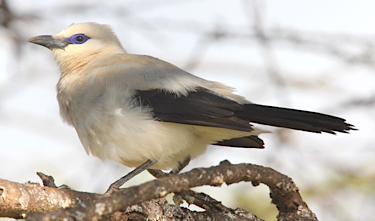
Stresemann's
Bush-Crow is perhaps Ethiopia's most special, at least
distinctive, endemic. Reminding those who know western
North America of Clark's Nutcracker, it is a monotypic
genus without close relatives, living in a small region of
bushed grassland with scattered trees in southern
Ethiopia. Generally treated as a corvid, there is still an
outstanding question about even its proper family
affiliation (starlings?). Photo by guide Richard Webster)
CAPE CROW (Corvus
capensis)
PIED CROW (Corvus albus)
SOMALI CROW
(Corvus edithae)
FAN-TAILED RAVEN
(Corvus rhipidurus)
THICK-BILLED RAVEN
(Corvus crassirostris)
[E]
Alaudidae (Larks)
SINGING BUSHLARK (Mirafra cantillans)
GILLETT'S LARK
(Mirafra gilletti) [E]
SIDAMO LARK
(Heteromirafra sidamoensis) [E]
FOXY LARK (Calendulauda alopex)
CHESTNUT-HEADED
SPARROW-LARK (Eremopterix
signatus)
ERLANGER'S LARK
(Calandrella erlangeri) [E]
SOMALI SHORT-TOED
LARK (Calandrella somalica)
SHORT-TAILED LARK
(Pseudalaemon fremantlii)
THEKLA LARK
(Galerida theklae)
Hirundinidae (Swallows)
PLAIN MARTIN (Riparia paludicola)
BANK SWALLOW
(Riparia riparia) [b]
ROCK MARTIN
(Ptyonoprogne fuligula)
BARN SWALLOW
(Hirundo rustica) [b]
ETHIOPIAN SWALLOW
(Hirundo aethiopica)
WIRE-TAILED
SWALLOW (Hirundo smithii)
WHITE-TAILED
SWALLOW (Hirundo megaensis)
[E]
RED-RUMPED SWALLOW
(Cecropis daurica)
LESSER
STRIPED-SWALLOW (Cecropis
abyssinica)
BLACK SAWWING
(Psalidoprocne pristoptera pristoptera)
BLACK SAWWING
(Psalidoprocne pristoptera antinorii)
Paridae (Chickadees and Tits)
WHITE-WINGED BLACK-TIT (Melaniparus leucomelas)
WHITE-BACKED
BLACK-TIT (Melaniparus
leuconotus) [E]
SOMALI TIT
(Melaniparus thruppi)
Remizidae (Penduline-Tits)
MOUSE-COLORED PENDULINE-TIT (Anthoscopus musculus)
Pycnonotidae (Bulbuls)
COMMON BULBUL (COMMON) (Pycnonotus barbatus schoanus)
COMMON BULBUL
(COMMON) (Pycnonotus barbatus
spurius)
COMMON BULBUL
(SOMALI) (Pycnonotus barbatus
somaliensis)
COMMON BULBUL
(DODSON'S) (Pycnonotus
barbatus dodsoni)
Macrosphenidae (African Warblers)
NORTHERN CROMBEC (Sylvietta brachyura)
RED-FACED CROMBEC
(Sylvietta whytii)
Phylloscopidae (Leaf-Warblers)
BROWN WOODLAND-WARBLER (Phylloscopus umbrovirens)
WILLOW WARBLER
(Phylloscopus trochilus) [b]
Acrocephalidae (Reed-Warblers and Allies)
EASTERN OLIVACEOUS WARBLER (Hippolais pallida)
[b]
EURASIAN
REED-WARBLER (Acrocephalus
scirpaceus) [b]
LESSER
SWAMP-WARBLER (Acrocephalus
gracilirostris)
Locustellidae (Grassbirds and Allies)
CINNAMON BRACKEN-WARBLER (Bradypterus cinnamomeus)
Cisticolidae (Cisticolas and Allies)
YELLOW-BREASTED APALIS (Apalis flavida)
GREEN-BACKED
CAMAROPTERA (GRAY-BACKED) (Camaroptera
brachyura brevicaudata)
RED-FRONTED
WARBLER (Urorhipis rufifrons)
GRAY WREN-WARBLER
(Calamonastes simplex)
RED-FACED
CISTICOLA (Cisticola
erythrops) [*]
SINGING CISTICOLA
(Cisticola cantans)
BORAN CISTICOLA
(Cisticola bodessa)
RATTLING CISTICOLA
(Cisticola chiniana)
WINDING CISTICOLA
(ETHIOPIAN) (Cisticola
galactotes lugubris) [E]
FOXY CISTICOLA
(Cisticola troglodytes)
TINY CISTICOLA
(Cisticola nana)
PECTORAL-PATCH
CISTICOLA (Cisticola
brunnescens)
BUFF-BELLIED
WARBLER (Phyllolais pulchella)
TAWNY-FLANKED
PRINIA (Prinia subflava)
PALE PRINIA
(Prinia somalica)
YELLOW-BELLIED
EREMOMELA (Eremomela
icteropygialis)
Sylviidae (Old World Warblers)
ABYSSINIAN CATBIRD (Parophasma galinieri)
[E]
AFRICAN HILL
BABBLER (Pseudoalcippe
abyssinica)
BROWN WARBLER
(Parisoma lugens griseiventre) [E]
BANDED WARBLER
(Parisoma boehmi)
Zosteropidae (Yuhinas, White-eyes, and
Allies)
BROAD-RINGED WHITE-EYE (MONTANE)
(Zosterops poliogastrus poliogastrus)
WHITE-BREASTED
WHITE-EYE (Zosterops
abyssinicus)
Leiothrichidae (Laughingthrushes)
RUFOUS CHATTERER (Turdoides rubiginosa)
WHITE-RUMPED
BABBLER (Turdoides leucopygia)
[E]
Muscicapidae (Old World Flycatchers)
GRAYISH FLYCATCHER (Bradornis microrhynchus)
ABYSSINIAN
SLATY-FLYCATCHER (Melaenornis
chocolatinus) [E]
NORTHERN
BLACK-FLYCATCHER (Melaenornis
edolioides)
DUSKY-BROWN
FLYCATCHER (Muscicapa adusta)
RED-BACKED
SCRUB-ROBIN (Cercotrichas
leucophrys)
RUEPPELL'S
ROBIN-CHAT (Cossypha semirufa)
WHITE-BROWED
ROBIN-CHAT (Cossypha heuglini)
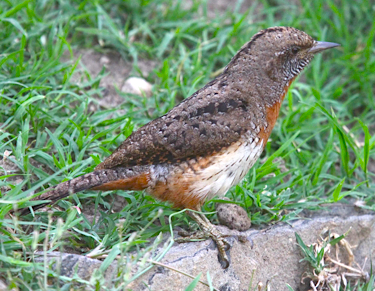
Rufous-necked
(Red-throated) Wryneck has a spotty distribution around
Africa. This ant-eating woodpecker was enjoyed near Lake
Langano as it foraged tamely on the ground. (Photo by
guide Richard Webster)
SPOTTED MORNING-THRUSH (Cichladusa guttata)
LITTLE ROCK-THRUSH
(Monticola rufocinereus)
STONECHAT (Saxicola torquatus)
RUEPPELL'S CHAT
(Myrmecocichla melaena) [E]
MOCKING CLIFF-CHAT
(Thamnolaea cinnamomeiventris)
WHITE-WINGED
CLIFF-CHAT (Thamnolaea
semirufa) [E]
SOMBRE CHAT
(Cercomela dubia) [E]
BLACKSTART
(Cercomela melanura)
MOORLAND CHAT
(Cercomela sordida)
NORTHERN WHEATEAR
(Oenanthe oenanthe) [b]
MOURNING WHEATEAR
(SCHALOW'S) (Oenanthe lugens
lugubris) [E]
RED-BREASTED
WHEATEAR (Oenanthe bottae)
Turdidae (Thrushes and Allies)
ABYSSINIAN GROUND-THRUSH (Zoothera piaggiae)
GROUNDSCRAPER
THRUSH (Psophocichla
litsipsirupa)
ABYSSINIAN THRUSH
(Turdus abyssinicus abyssinicus)
AFRICAN THRUSH
(Turdus pelios)
AFRICAN BARE-EYED
THRUSH (Turdus tephronotus)
Sturnidae (Starlings)
WATTLED STARLING (Creatophora cinerea)
GREATER BLUE-EARED
GLOSSY-STARLING (Lamprotornis
chalybaeus)
RUEPPELL'S
GLOSSY-STARLING (Lamprotornis
purpuroptera)
GOLDEN-BREASTED
STARLING (Lamprotornis regius)
SUPERB STARLING
(Lamprotornis superbus)
SHELLEY'S STARLING
(Lamprotornis shelleyi)
VIOLET-BACKED
STARLING (Cinnyricinclus
leucogaster)
WHITE-CROWNED
STARLING (Spreo albicapillus)
RED-WINGED
STARLING (Onychognathus morio)
SLENDER-BILLED
STARLING (Onychognathus
tenuirostris)
BRISTLE-CROWNED
STARLING (Onychognathus
salvadorii)
WHITE-BILLED
STARLING (Onychognathus
albirostris)
[E]
MAGPIE STARLING
(Speculipastor bicolor)
Buphagidae (Oxpeckers)
RED-BILLED OXPECKER (Buphagus erythrorhynchus)
Nectariniidae (Sunbirds and Spiderhunters)
COLLARED SUNBIRD (Hedydipna collaris)
NILE VALLEY
SUNBIRD (Hedydipna metallica)
SCARLET-CHESTED
SUNBIRD (Chalcomitra
senegalensis)
HUNTER'S SUNBIRD
(Chalcomitra hunteri)
TACAZZE SUNBIRD
(Nectarinia tacazze)
BEAUTIFUL SUNBIRD
(Cinnyris pulchellus)
MARIQUA SUNBIRD
(Cinnyris mariquensis)
TSAVO SUNBIRD
(Cinnyris tsavoensis)
SHINING SUNBIRD
(Cinnyris habessinicus)
VARIABLE SUNBIRD
(Cinnyris venustus)
Motacillidae (Wagtails and Pipits)
MOUNTAIN WAGTAIL (Motacilla clara)
AFRICAN PIED
WAGTAIL (Motacilla aguimp)
AFRICAN PIPIT
(Anthus cinnamomeus)
LONG-BILLED PIPIT
(Anthus similis)
PLAIN-BACKED PIPIT
(Anthus leucophrys)
ABYSSINIAN
LONGCLAW (Macronyx
flavicollis) [E]
Emberizidae (Buntings, Sparrows and
Allies)
CINNAMON-BREASTED BUNTING (Emberiza tahapisi)
Fringillidae (Siskins, Crossbills, and
Allies)
ANKOBER SERIN (Carduelis ankoberensis)
[E]
YELLOW-CROWNED
CANARY (Serinus flavivertex)
YELLOW-FRONTED
CANARY (Serinus mozambicus)
ABYSSINIAN SISKIN
(Serinus nigriceps) [E]
AFRICAN CITRIL
(Serinus citrinelloides)
REICHENOW'S
SEEDEATER (Serinus reichenowi)
YELLOW-RUMPED
SERIN (Serinus xanthopygius)
[E]
WHITE-BELLIED
CANARY (Serinus dorsostriatus)
YELLOW-THROATED
SERIN (Serinus flavigula)
[E]
SALVADORI'S SERIN
(Serinus xantholaemus) [E]
NORTHERN
GROSBEAK-CANARY (Serinus
donaldsoni)
STREAKY SEEDEATER
(Serinus striolatus)
BROWN-RUMPED
SEEDEATER (Serinus
tristriatus) [E]
Passeridae (Old World Sparrows)
SHELLEY'S RUFOUS SPARROW (Passer shelleyi)
SWAINSON'S SPARROW
(Passer swainsonii)
CHESTNUT SPARROW
(Passer eminibey)
YELLOW-SPOTTED
PETRONIA (Petronia pyrgita)
BUSH PETRONIA
(Petronia dentata)
Ploceidae (Weavers and Allies)
RED-BILLED BUFFALO-WEAVER (Bubalornis niger)
WHITE-HEADED
BUFFALO-WEAVER (Dinemellia
dinemelli)
WHITE-BROWED
SPARROW-WEAVER (Plocepasser
mahali)
RED-HEADED WEAVER
(Anaplectes rubriceps)
BAGLAFECHT WEAVER
(Ploceus baglafecht)
LITTLE WEAVER
(Ploceus luteolus)
SPECTACLED WEAVER
(Ploceus ocularis)
LESSER
MASKED-WEAVER (Ploceus
intermedius)
VITELLINE
MASKED-WEAVER (Ploceus
vitellinus)
RUEPPELL'S WEAVER
(Ploceus galbula)
SPEKE'S WEAVER
(Ploceus spekei)
VILLAGE WEAVER
(Ploceus cucullatus)
CHESTNUT WEAVER
(Ploceus rubiginosus)
RED-BILLED QUELEA
(Quelea quelea)
ORANGE BISHOP
(Euplectes franciscanus)
BLACK-WINGED
BISHOP (Euplectes hordeaceus)
YELLOW BISHOP
(Euplectes capensis)
WHITE-WINGED
WIDOWBIRD (Euplectes
albonotatus)
RED-COLLARED
WIDOWBIRD (Euplectes ardens)
GROSBEAK WEAVER
(Amblyospiza albifrons)
Estrildidae (Waxbills and Allies)
YELLOW-BELLIED WAXBILL (Coccopygia quartinia)
FAWN-BREASTED
WAXBILL (ABYSSINIAN) (Estrilda
paludicola ochrogaster) [E]
CRIMSON-RUMPED
WAXBILL (Estrilda rhodopyga)
RED-RUMPED WAXBILL
(Estrilda charmosyna)
RED-CHEEKED
CORDONBLEU (Uraeginthus
bengalus)
PURPLE GRENADIER
(Granatina ianthinogaster)
RED-BILLED PYTILIA
(Pytilia lineata)
GREEN-WINGED
PYTILIA (Pytilia melba)
RED-BILLED
FIREFINCH (Lagonosticta
senegala)
CUT-THROAT
(Amadina fasciata)
BRONZE MANNIKIN
(Spermestes cucullatus)
BLACK-AND-WHITE
MANNIKIN (Spermestes bicolor)
AFRICAN SILVERBILL
(Euodice cantans)
Viduidae (Indigobirds)
PIN-TAILED WHYDAH (Vidua macroura)
EASTERN
PARADISE-WHYDAH (Vidua
paradisaea)
VILLAGE INDIGOBIRD
(Vidua chalybeata)
BLACK-FACED VERVET
MONKEY (Cercopithecus
aethiops)
OLIVE BABOON
(Papio anubis)
GELADA (Theropithecus gelada) [E]
MANTLED GUEREZA
(Colobus guereza)
CAPE HARE (Lepus capensis)
STARCK'S HARE
(Lepus starcki) [E]
UNSTRIPED GROUND
SQUIRREL (Xerus rutilus)
STRIPED GROUND
SQUIRREL (Xerus erythropus)
ETHIOPIAN ROOT-RAT
(Tachyoryctes macrocephalus)
[E]
SIMIEN FOX
(ETHIOPIAN WOLF) (Canis
simensis) [E]
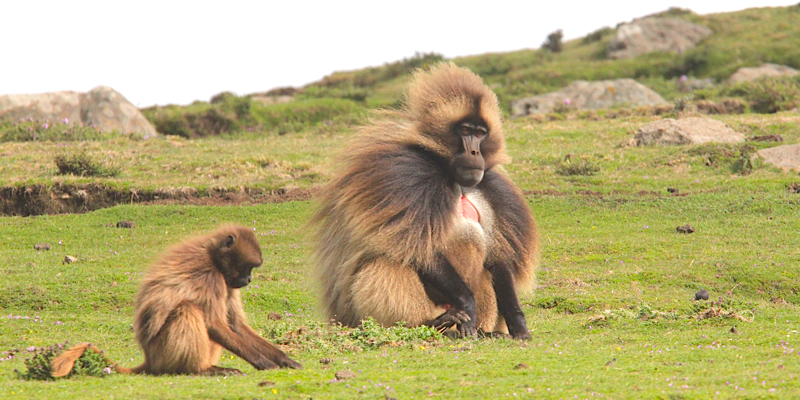
A male Gelada
with one of its young. This huge primate looks fierce, but
it is a vegetarian (they are plucking grass to eat).
Gelada is related to the baboons, but is not a baboon, but
a separate lineage in a monotypic genus. (Photo by guide
Richard Webster)
BLACK-BACKED JACKAL (Canis mesomelas)
COMMON JACKAL
(Canis aureus)
SLENDER MONGOOSE
(Herpestes sanguineus)
SPOTTED HYAENA
(Crocuta crocuta) [*]
ROCK HYRAX
(Procavia capensis)
BUSH
(YELLOW-SPOTTED) HYRAX (Heterohyrax
brucei)
WARTHOG (Phacochoerus aethiopicus)
HIPPOPOTAMUS
(Hippopotamus amphibius)
MOUNTAIN NYALA
(Tragelaphus buxtoni) [E]
MENELICK'S
BUSHBUCK (Tragelaphus scriptus
meneliki) [E]
GREATER KUDU
(Tragelaphus strepsiceros)
LESSER KUDU
(Tragelaphus imberbis)
BOHOR REEDBUCK
(Redunca redunca)
BEISA ORYX
(Oryx beisa)
KLIPSPRINGER
(Oreotragus oreotragus)
SALT'S DIK-DIK
(Madoqua saltiana)
GUENTHER'S DIK-DIK
(Madoqua guentheri)
SOEMMERING'S
GAZELLE (Gazella soemmerringi)
[E]
Other critters:
We saw many, many rodents. More interesting than the ones
that chewed any food left in our rooms at Awash, or left a
sizeable hole in REW's backpack, were the abundant native
species in the highands. The problem is identifying them! For
instance, there are 14 species of rodent in Bale Mtns. N.P.,
half of them endemic. IDs were of Naked-soled Gerbil north of
Addis and Groove-toothed Rat in the Bale Mtns., plus a
suspicion that the common rodent on the Sanetti Plateau is a
Stenocephalemys, a Ethiopian Meadow Rat, but we really don't
know.
In addition, we saw the sand being thrown out of burrows by
Naked Mole-Rats, but we did not have a "countable" look!
Leopard Tortoise: Some nice ones at Bilen Lodge, Awash N.P.,
and Sof Omar.
Nile Crocodile: Awash Falls N.P.
Black Mamba: from the bus, crossing the road in Awash N.P.
Savannah Monitor: en route to Negele.
Agama lizards: widespread.
Totals for the tour: 402 bird taxa and 28 mammal taxa








